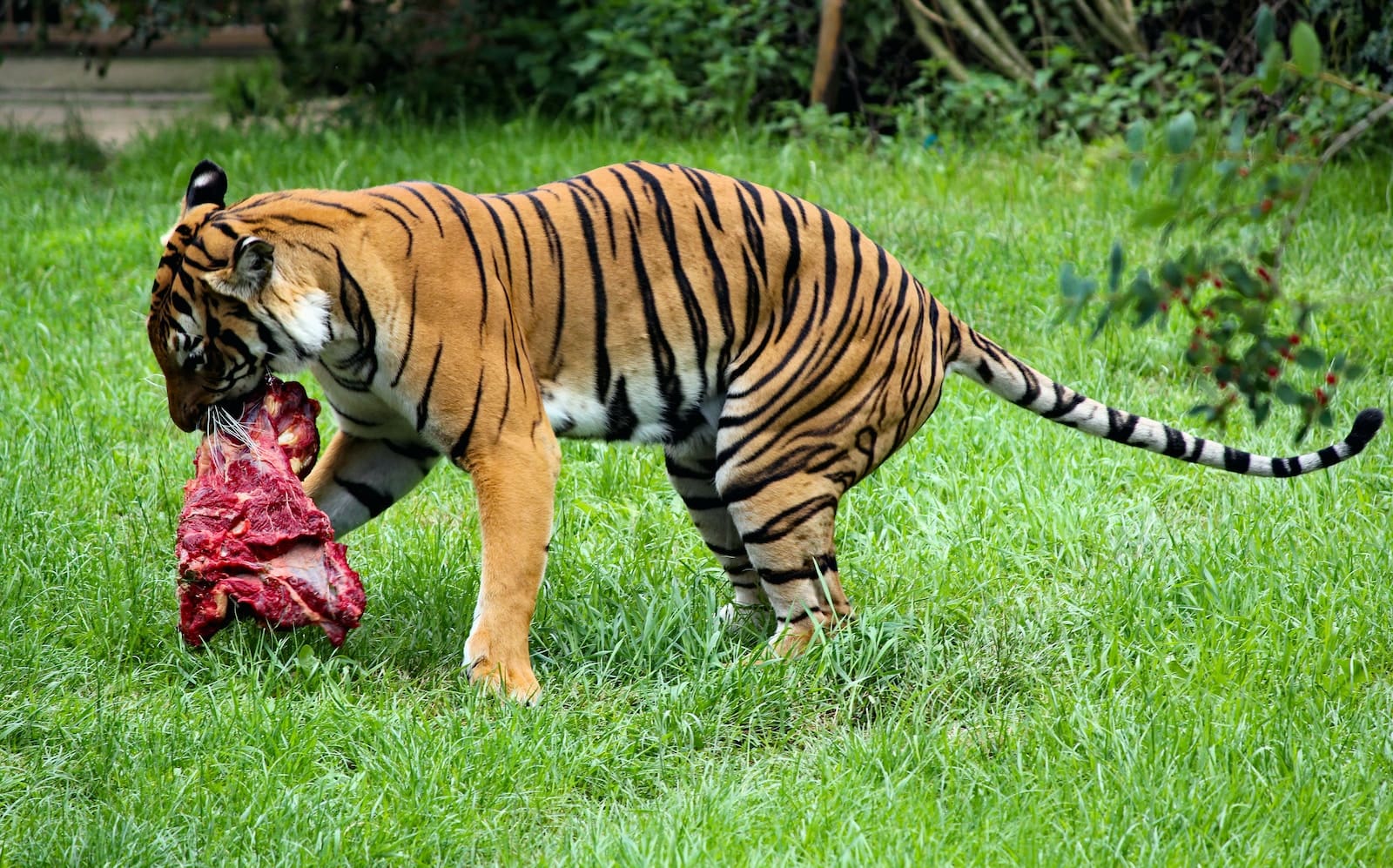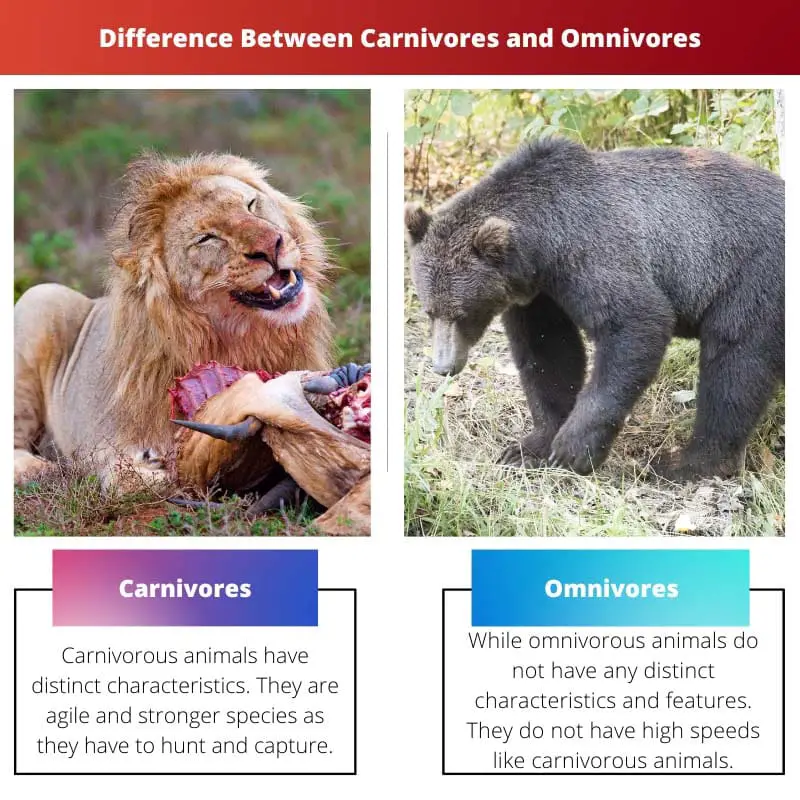Species are classified and segregated based on their feeding pattern. Further species are placed in the trophic level, which helps in determining the food web or food chain of the ecosystem.
The third trophic level is occupied by two main categories, which are carnivores and omnivores.
Key Takeaways
- Carnivores are animals that exclusively eat other animals for their nutritional requirements.
- Omnivores consume both plant and animal matter to fulfill their nutritional needs.
- Carnivores have specialized digestive systems for processing animal matter, whereas omnivores have adaptable digestive systems for processing various food sources.
Carnivores vs Omnivores
Carnivores have specialized teeth, strong jaws for tearing and chewing meat, and a short digestive tract to process their high-protein diet quickly. Omnivores have a more diverse set of teeth, a longer digestive tract to better digest plant-based foods and sharp incisors for tearing meat.

Carnivorous animals have distinct characteristics. They are agile and stronger species as they have to hunt and capture. They have sharp teeth and claws, which help in tearing the prey efficiently.
Carnivores play the role of checking the animal population in the food web or chain.
While omnivorous animals do not have any distinct characteristics and features, they do not have high speeds like carnivorous animals. The teeth are sharp to bite and cut the food.
Omnivores have a crucial role in the food chain or web as they can check both vegetation growth and animal growth of the ecosystem.
Comparison Table
| Parameters of Comparison | Carnivores | Omnivores |
|---|---|---|
| Word derivation | Carnivores has been derived from two Latin words “Caro” and “vorare” | Omnivores has been derived from two Latin words called “omnis” and “vora” |
| Sub-categories | Hypercarnivores and mesocarnivores | Frugivores, granivores, insectivores, pinnipeds, felines, and various other types |
| Chewing capacity | Carnivores do not chew their food for long | Omnivores chew their food for a long time |
| Intestine length | Carnivores have intestines that are about 3 to 6 times of the body length | Omnivores have intestines which are about 4 to 6 times of the body length |
| Strength | Carnivores are stronger animals as they have to hunt and capture their prey | Omnivores are comparatively less strong animals as they have a flexible diet |
What is Carnivores?
Carnivores are those animals that eat the flesh of other animals to survive. They are also known as meat-eater animals.
The derivation of the term carnivore has been from the merging of two Latin words, “caro” and “vorare”, which means ” flesh” and “to devour”, respectively.
The entire nutrition and requirements of food and energy of such animals are fulfilled from the issues of other animals.
Carnivores can survive either by scavenging or hunting. They devour all animal tissues, whether fat, muscle, or other soft tissues.
The placement of a carnivore in the food chain is at the top and is called an apex predator, as it cannot be preyed upon by other animals.
These animals have a characteristic speed, strength, teeth, claws, and enhanced senses for hunting and capturing prey.
Carnivores are further classified into two major types. They are hypercarnivores and mesocarnivores.
Hypercarnivores are also known as obligate carnivores and are referred to as animals that have sole dependence on the meat or flesh of the animal to fulfil nutrient requirements.
Mesocarnivores are also known as facultative carnivores and are referred to as those animals that also survive on the consumption of non-animal food.
Carnivores are not only restricted to the animal kingdom, but other genera also exhibit such examples as carnivorous plants and carnivorous fungi.
Carnivorous plants are predominantly referred to the insectivores, while carnivorous fungi prey on microscopic invertebrates like springtails, nematodes, and amoebae.

What is Omnivores?
Omnivores are referred to as those animals which consume both non-animal as well as animal food for survival. Such animals obtain nutrients and energy from animal and plant matter.
The derivation of the term omnivore is from the merging of two Latin words called “omnis” and “vora”, which means “all” and “to devour or eat”, respectively.
Omnivores have a flexible diet and can incorporate various food sources like bacteria, algae, and fungi. They belong from diverse backgrounds.
The consumption capabilities of omnivores have independently evolved. They can digest carbohydrates, fibre, fat, and other nutrients received from the sources.
Omnivores are further classified into sub-categories based on the animals’ feeding behaviour.
Frugivores, granivores, insectivores, and various other types are omnivores but have a particular niche of feeding behaviour and have a specific preference for foods.
Omnivores have an essential role in the food chain. They also fall under the category of scavengers since some feed on the remains of dead animals.
Various animals exhibit omnivorous characteristics in the wild, like rats, pigs, mice, hominids, opossums, badgers, chipmunks, skunks, hedgehogs, raccoons, and others.
Not all were omnivorous from the beginning, but the change is mainly due to scarcity and unavailability. The placement of omnivores is in the 3rd trophic level of the food chain and is placed alongside flesh-eating carnivores.

Main Differences Between Carnivores and Omnivores
- Carnivores have sharper claws, while omnivores have comparatively less sharp claws.
- The facial muscles of carnivores are reduced, while the facial muscles of omnivores can be reduced or complex.
- The canines of carnivores are extremely long, sharp and curved, while the canines of omnivores are comparatively less sharp, curved, and longer.
- Carnivores have sharp, blade-shaped, and jagged teeth molars, while omnivores have sharp yet flattened teeth molars.
- Carnivores have short and pointed incisors, while omnivores are comparatively less short and pointed.




